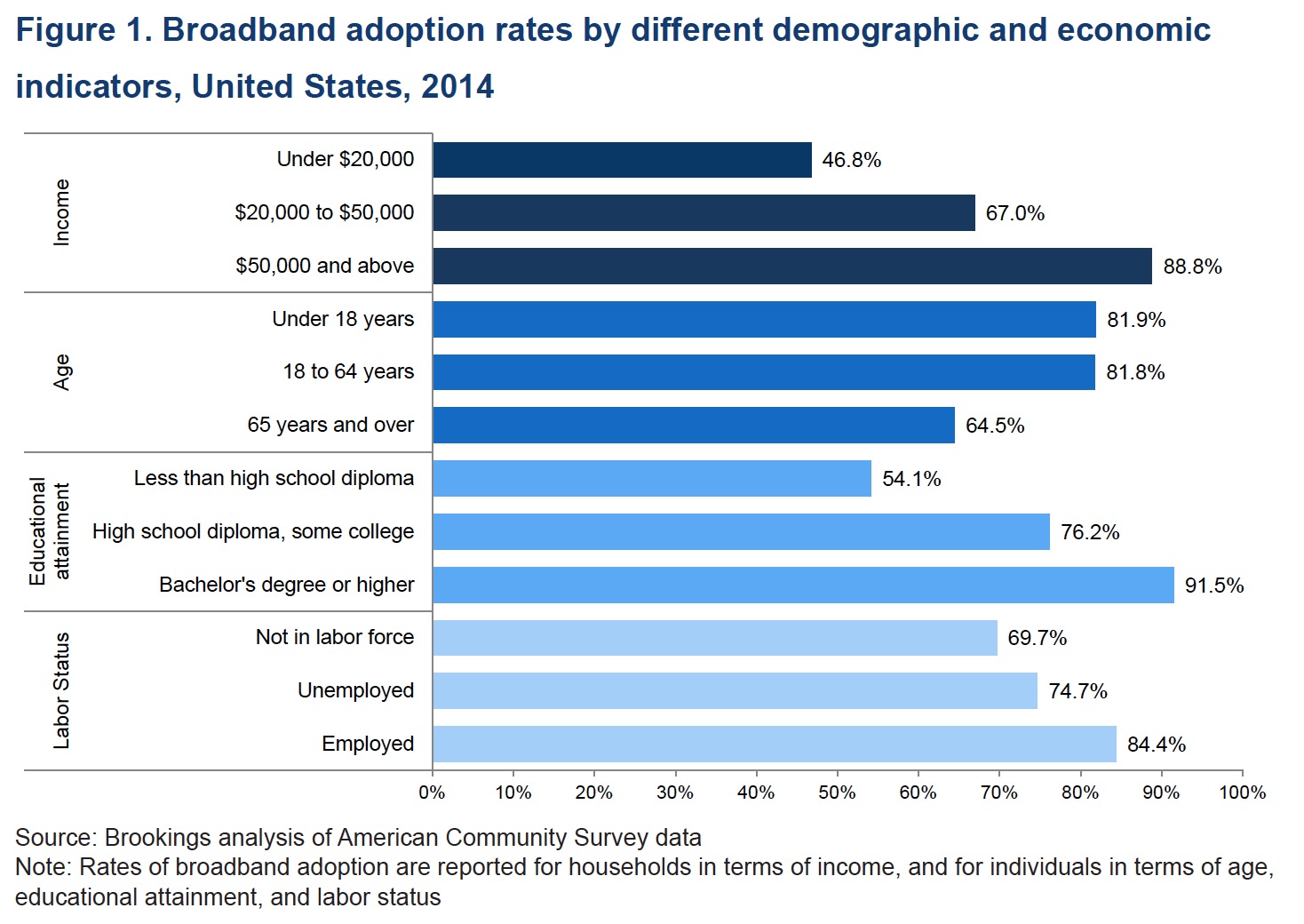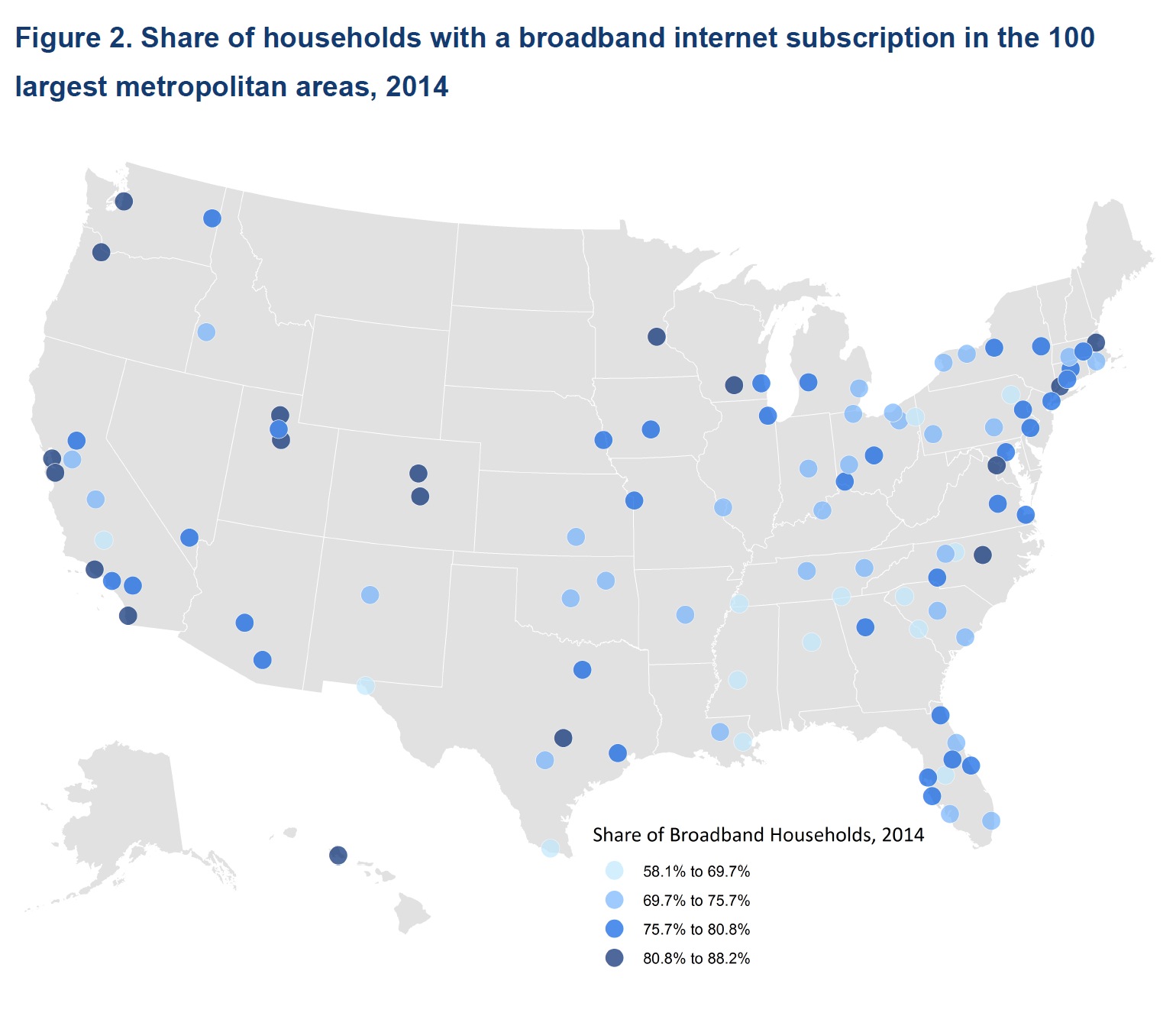BROOKINGS INSTITUTION
METROPOLITAN POLICY PROGRAM
Written by Adie Tomer and Joseph Kane
For many Americans, daily life orbits around a high-speed Internet connection. Workers and students go online to communicate and learn. Families stay in touch through live video feeds. Job seekers often need an electronic resume and an email address for applications. Smartphones put maps, social networks, and video streams in people’s pockets. The American economy has gone digital.
Yet, the rapid transition to online content and services comes at a price. Buying cheaper goods directly from wholesalers, immediately accessing government services, and finding employment opportunities are increasingly only available to those who have an online connection. As a result, individuals without a private Internet subscription or digital skills are at a disadvantage when it comes to accessing economic opportunity. Individuals with digital skills but no private broadband subscription –likely due to the United States’ relatively expensive broadband service—must spend extra time getting to public connection points, such as libraries. And since everyone cannot regularly access the Internet, government agencies must operate both digital and analog systems, and private businesses miss out on an expanded customer base.
There is no question that the Internet is a huge boon to the economy and society, but maximizing its potential is only possible if all individuals are online. As a result, it is critical that policymakers closely track broadband adoption rates: the share of households with a DSL, cable, fiber optic, mobile broadband, satellite, or fixed wireless subscription.
Until now, public, private, and civic leaders have frequently concentrated on broadband adoption at a national or international scale, looking at how rates vary across large segments of the population. However, new survey questions from the U.S. Census Bureau enable analysis at the metropolitan scale, creating new ways to measure and understand where America falls short in getting people online. This subnational approach is especially important because local and state governments play a lead role in guiding Internet policy, including infrastructure deployment, public outreach, skills development, and affordability programs.
This brief uses 2013 and 2014 American Community Survey data to track current and changing broadband adoption rates at the metropolitan scale, while using a combination of other Census and Internet speed data to model what factors affect metropolitan adoption rates. In turn, the results of this analysis have clear implications for efforts to address the significant gaps in American Internet adoption.
Further information on the analytical approach and methods is available in the appendix.
While 75.1 percent of American households had a broadband Internet subscription in 2014, there is enormous variation in U.S. digital connectivity across demographic groups and between metropolitan areas.
In 2014, more than 87 million households—or three-quarters of all households nationally—had a broadband Internet subscription, speaking to the importance of having a reliable, efficient connection to digital information networks across the United States. There’s little question broadband has evolved into the defining infrastructure of the 21st century.
Yet despite its central role in promoting economic prosperity, broadband adoption remains highly uneven among specific groups, limiting opportunity for many people. For example, only 46.8 percent of households with incomes under $20,000 annually had a broadband subscription in 2014, compared to 88.8 percent of households earning $50,000 or more. Likewise, while 54.1 percent of individuals with less than a high school diploma had a broadband subscription, 91.5 percent with a bachelor’s degree or higher did. Relatively low adoption rates also appear among older age groups—64.5 percent of individuals 65 years and older—while those not in the labor force (69.7 percent) subscribe to broadband at marginally lower rates relative to the national average.
Broadband adoption also varies substantially across different U.S. markets, including the country’s 100 largest metropolitan areas. Although these areas tend to have higher adoption rates (77.8 percent) than the country as a whole (75.1 percent), these rates can still differ by up to 30 percentage points or more in some cases. Tech centers like San Jose (88.2 percent), Seattle (84.8 percent), and Boston (82.7 percent), for instance, far exceed the shares seen in Lakeland (64.1 percent), Greensboro (64 percent), and McAllen (58.1 percent). Table 1 includes the top and bottom performers across all metro areas, demonstrating the enormous range seen across the country. However, as revealed in Figure 2, the level of variation among broader geographical regions in the West, South, and East is less clear, suggesting local dynamics may be a more important indicator of broadband adoption.
Download full version (PDF): Broadband Adoption Rates and Gaps in U.S. Metropolitan Areas
About the Brookings Metropolitan Policy Program
www.brookings.edu/about/programs/metro
The Metropolitan Policy Program at Brookings is redefining the challenges facing metropolitan America and identifying assets and promoting innovative solutions to help communities grow in more productive, inclusive, and sustainable ways.
Tags: Adie Tomer, Brookings Institution, Internet, Joseph Kane, Metropolitan Policy Program








 RSS Feed
RSS Feed